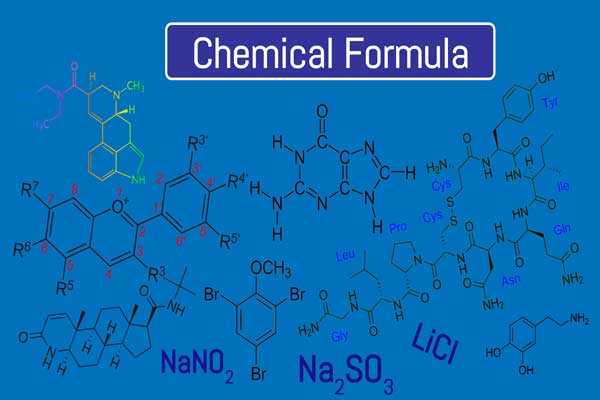How do you write a Chemical Formula? || Examples of Chemical Formula?
A chemical formula describes the composition of chemical compounds and can contain information about the structure. A chemical formula always contains information on the chemical elements contained in a compound and on the numerical ratio of the particles occurring in the compound.
The element symbols must be distinguished from the formulas: H for hydrogen, Mg for magnesium, N for nitrogen. If two or more atoms of the same elements combine to form a molecule, this is in turn identified by a (molecular) formula: H2 for hydrogen, N2 for nitrogen, O3 for ozone.
There are different chemical formulas:
Ratio formula
It is made up of element symbols and small, subscript numbers (indices) and only reflect the ratio in which the individual chemical elements are contained in a chemical compound. Integer ratios are used.
Example: The ratio formula for benzene is C1H1, the ratio formula for aluminum sulfate is Al2O12S3.
Sum formula
The sum formula indicates the number of atoms of the chemical elements contained in a compound. In the case of molecules, this also indicates the actual frequency of the atoms of different elements in the molecule. Molecular formulas of salts generally correspond to their ratio formulas but are usually given in the form of formula units which satisfy the stoichiometry of the compound.
Example: The molecular formula for benzene is C6H6, the molecular formula (formula unit) of aluminum sulfate is Al2(SO4)3.
Structural formula
In addition to the number of different atoms in a molecule, the structural formula also shows their arrangement with respect to one another, i.e. it also provides information about the type of atoms and the nature of their linkages (bonds), possibly also about bond angles and bond lengths.
The letters stand for individual atoms. A line corresponds to an electron pair that is present in an electron cloud/orbital and either forms the bond between atoms or is a so-called free electron pair. Correspondingly, two parallel lines mean a double bond.
- Ammonia Formula || why ammonia is toxic || Ammonia Poisoning
- Why Ozone Layer is Important || Ozone Layer Depletion
- What is the Concentration of solution || How Concentration Affects Reaction
- Why Carbon Cycle is Important || How it Works
- Haloalkanes and Haloarenes NCERT Solutions || Haloalkane Structure
- Carbon Dioxide Cycle and Formula || How Carbon Dioxide is Produced
The use of the names of the individual formula types is not always regulated uniformly and many terms are used synonymously. Structural formulas are mainly used to describe molecules.
However, a structural formula is also used to describe ions in crystals, since the ions in the ion crystals are also “structured”. A formula used for salt-like substances should be referred to as a formula unit, not as a structural formula or empirical formula. The actual structure of a salt-like compound is only clarified by its crystal structure.
Constitutional formula
Lewis formula: without considering the bond angles and bond lengths, all binding and non-binding electron pairs or lonely electrons are shown.
The skeletal formula, shortened spelling in organic chemistry
Wedge line formula to represent stereochemistry
Fischer projection formula: for chiral molecules such as amino acids or sugar
Haworth projection, for 5- to 6-ringed molecules like sugar
Newman projection formula: to represent the conformation
Structure codes: INCHI, SMILES, WLN

